Yuanfan Guo
TiKMiX: Take Data Influence into Dynamic Mixture for Language Model Pre-training
Aug 25, 2025Abstract:The data mixture used in the pre-training of a language model is a cornerstone of its final performance. However, a static mixing strategy is suboptimal, as the model's learning preferences for various data domains shift dynamically throughout training. Crucially, observing these evolving preferences in a computationally efficient manner remains a significant challenge. To address this, we propose TiKMiX, a method that dynamically adjusts the data mixture according to the model's evolving preferences. TiKMiX introduces Group Influence, an efficient metric for evaluating the impact of data domains on the model. This metric enables the formulation of the data mixing problem as a search for an optimal, influence-maximizing distribution. We solve this via two approaches: TiKMiX-D for direct optimization, and TiKMiX-M, which uses a regression model to predict a superior mixture. We trained models with different numbers of parameters, on up to 1 trillion tokens. TiKMiX-D exceeds the performance of state-of-the-art methods like REGMIX while using just 20% of the computational resources. TiKMiX-M leads to an average performance gain of 2% across 9 downstream benchmarks. Our experiments reveal that a model's data preferences evolve with training progress and scale, and we demonstrate that dynamically adjusting the data mixture based on Group Influence, a direct measure of these preferences, significantly improves performance by mitigating the underdigestion of data seen with static ratios.
FreqPrior: Improving Video Diffusion Models with Frequency Filtering Gaussian Noise
Feb 05, 2025Abstract:Text-driven video generation has advanced significantly due to developments in diffusion models. Beyond the training and sampling phases, recent studies have investigated noise priors of diffusion models, as improved noise priors yield better generation results. One recent approach employs the Fourier transform to manipulate noise, marking the initial exploration of frequency operations in this context. However, it often generates videos that lack motion dynamics and imaging details. In this work, we provide a comprehensive theoretical analysis of the variance decay issue present in existing methods, contributing to the loss of details and motion dynamics. Recognizing the critical impact of noise distribution on generation quality, we introduce FreqPrior, a novel noise initialization strategy that refines noise in the frequency domain. Our method features a novel filtering technique designed to address different frequency signals while maintaining the noise prior distribution that closely approximates a standard Gaussian distribution. Additionally, we propose a partial sampling process by perturbing the latent at an intermediate timestep during finding the noise prior, significantly reducing inference time without compromising quality. Extensive experiments on VBench demonstrate that our method achieves the highest scores in both quality and semantic assessments, resulting in the best overall total score. These results highlight the superiority of our proposed noise prior.
Brick-Diffusion: Generating Long Videos with Brick-to-Wall Denoising
Jan 06, 2025



Abstract:Recent advances in diffusion models have greatly improved text-driven video generation. However, training models for long video generation demands significant computational power and extensive data, leading most video diffusion models to be limited to a small number of frames. Existing training-free methods that attempt to generate long videos using pre-trained short video diffusion models often struggle with issues such as insufficient motion dynamics and degraded video fidelity. In this paper, we present Brick-Diffusion, a novel, training-free approach capable of generating long videos of arbitrary length. Our method introduces a brick-to-wall denoising strategy, where the latent is denoised in segments, with a stride applied in subsequent iterations. This process mimics the construction of a staggered brick wall, where each brick represents a denoised segment, enabling communication between frames and improving overall video quality. Through quantitative and qualitative evaluations, we demonstrate that Brick-Diffusion outperforms existing baseline methods in generating high-fidelity videos.
EasyControl: Transfer ControlNet to Video Diffusion for Controllable Generation and Interpolation
Aug 23, 2024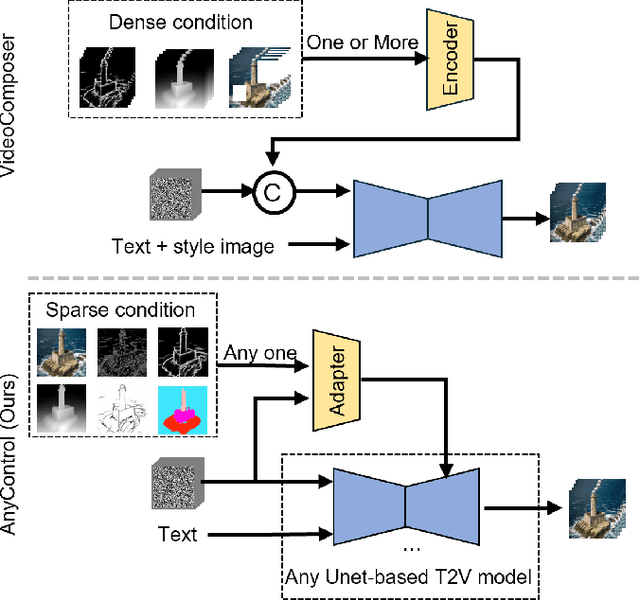
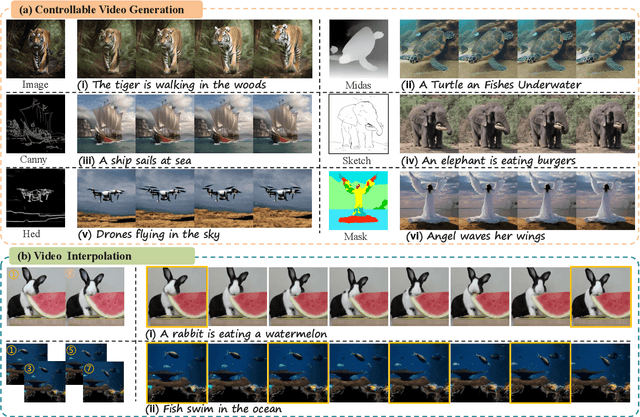
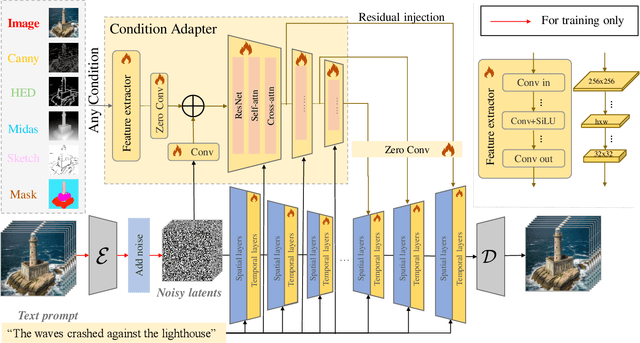
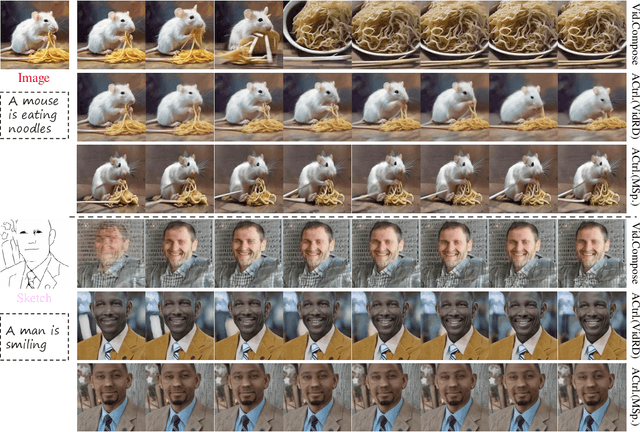
Abstract:Following the advancements in text-guided image generation technology exemplified by Stable Diffusion, video generation is gaining increased attention in the academic community. However, relying solely on text guidance for video generation has serious limitations, as videos contain much richer content than images, especially in terms of motion. This information can hardly be adequately described with plain text. Fortunately, in computer vision, various visual representations can serve as additional control signals to guide generation. With the help of these signals, video generation can be controlled in finer detail, allowing for greater flexibility for different applications. Integrating various controls, however, is nontrivial. In this paper, we propose a universal framework called EasyControl. By propagating and injecting condition features through condition adapters, our method enables users to control video generation with a single condition map. With our framework, various conditions including raw pixels, depth, HED, etc., can be integrated into different Unet-based pre-trained video diffusion models at a low practical cost. We conduct comprehensive experiments on public datasets, and both quantitative and qualitative results indicate that our method outperforms state-of-the-art methods. EasyControl significantly improves various evaluation metrics across multiple validation datasets compared to previous works. Specifically, for the sketch-to-video generation task, EasyControl achieves an improvement of 152.0 on FVD and 19.9 on IS, respectively, in UCF101 compared with VideoComposer. For fidelity, our model demonstrates powerful image retention ability, resulting in high FVD and IS in UCF101 and MSR-VTT compared to other image-to-video models.
HumanRefiner: Benchmarking Abnormal Human Generation and Refining with Coarse-to-fine Pose-Reversible Guidance
Jul 09, 2024



Abstract:Text-to-image diffusion models have significantly advanced in conditional image generation. However, these models usually struggle with accurately rendering images featuring humans, resulting in distorted limbs and other anomalies. This issue primarily stems from the insufficient recognition and evaluation of limb qualities in diffusion models. To address this issue, we introduce AbHuman, the first large-scale synthesized human benchmark focusing on anatomical anomalies. This benchmark consists of 56K synthesized human images, each annotated with detailed, bounding-box level labels identifying 147K human anomalies in 18 different categories. Based on this, the recognition of human anomalies can be established, which in turn enhances image generation through traditional techniques such as negative prompting and guidance. To further boost the improvement, we propose HumanRefiner, a novel plug-and-play approach for the coarse-to-fine refinement of human anomalies in text-to-image generation. Specifically, HumanRefiner utilizes a self-diagnostic procedure to detect and correct issues related to both coarse-grained abnormal human poses and fine-grained anomaly levels, facilitating pose-reversible diffusion generation. Experimental results on the AbHuman benchmark demonstrate that HumanRefiner significantly reduces generative discrepancies, achieving a 2.9x improvement in limb quality compared to the state-of-the-art open-source generator SDXL and a 1.4x improvement over DALL-E 3 in human evaluations. Our data and code are available at https://github.com/Enderfga/HumanRefiner.
Self-Adaptive Reality-Guided Diffusion for Artifact-Free Super-Resolution
Mar 25, 2024

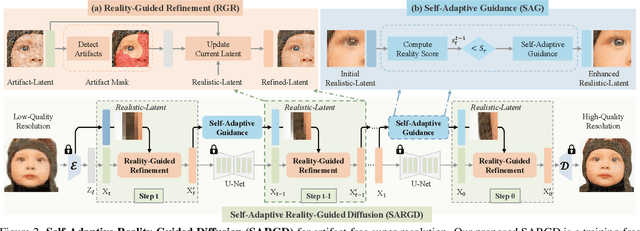
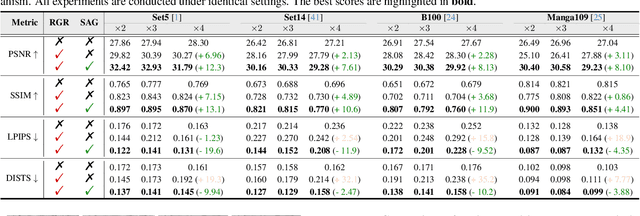
Abstract:Artifact-free super-resolution (SR) aims to translate low-resolution images into their high-resolution counterparts with a strict integrity of the original content, eliminating any distortions or synthetic details. While traditional diffusion-based SR techniques have demonstrated remarkable abilities to enhance image detail, they are prone to artifact introduction during iterative procedures. Such artifacts, ranging from trivial noise to unauthentic textures, deviate from the true structure of the source image, thus challenging the integrity of the super-resolution process. In this work, we propose Self-Adaptive Reality-Guided Diffusion (SARGD), a training-free method that delves into the latent space to effectively identify and mitigate the propagation of artifacts. Our SARGD begins by using an artifact detector to identify implausible pixels, creating a binary mask that highlights artifacts. Following this, the Reality Guidance Refinement (RGR) process refines artifacts by integrating this mask with realistic latent representations, improving alignment with the original image. Nonetheless, initial realistic-latent representations from lower-quality images result in over-smoothing in the final output. To address this, we introduce a Self-Adaptive Guidance (SAG) mechanism. It dynamically computes a reality score, enhancing the sharpness of the realistic latent. These alternating mechanisms collectively achieve artifact-free super-resolution. Extensive experiments demonstrate the superiority of our method, delivering detailed artifact-free high-resolution images while reducing sampling steps by 2X. We release our code at https://github.com/ProAirVerse/Self-Adaptive-Guidance-Diffusion.git.
PanGu-Draw: Advancing Resource-Efficient Text-to-Image Synthesis with Time-Decoupled Training and Reusable Coop-Diffusion
Dec 29, 2023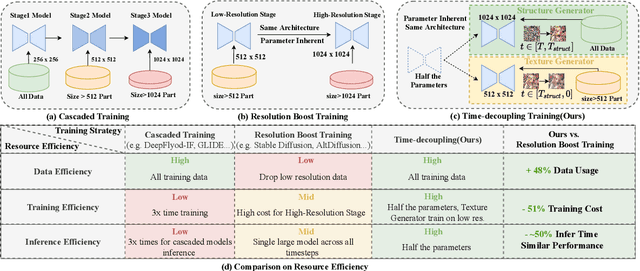

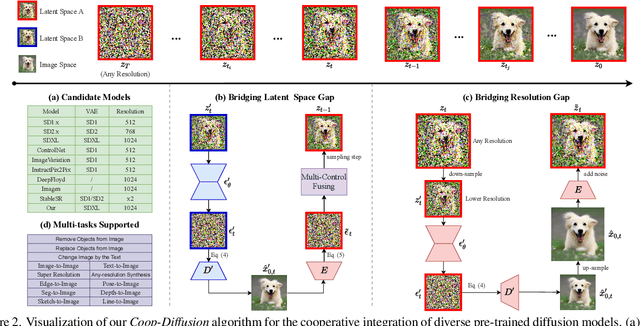

Abstract:Current large-scale diffusion models represent a giant leap forward in conditional image synthesis, capable of interpreting diverse cues like text, human poses, and edges. However, their reliance on substantial computational resources and extensive data collection remains a bottleneck. On the other hand, the integration of existing diffusion models, each specialized for different controls and operating in unique latent spaces, poses a challenge due to incompatible image resolutions and latent space embedding structures, hindering their joint use. Addressing these constraints, we present "PanGu-Draw", a novel latent diffusion model designed for resource-efficient text-to-image synthesis that adeptly accommodates multiple control signals. We first propose a resource-efficient Time-Decoupling Training Strategy, which splits the monolithic text-to-image model into structure and texture generators. Each generator is trained using a regimen that maximizes data utilization and computational efficiency, cutting data preparation by 48% and reducing training resources by 51%. Secondly, we introduce "Coop-Diffusion", an algorithm that enables the cooperative use of various pre-trained diffusion models with different latent spaces and predefined resolutions within a unified denoising process. This allows for multi-control image synthesis at arbitrary resolutions without the necessity for additional data or retraining. Empirical validations of Pangu-Draw show its exceptional prowess in text-to-image and multi-control image generation, suggesting a promising direction for future model training efficiencies and generation versatility. The largest 5B T2I PanGu-Draw model is released on the Ascend platform. Project page: $\href{https://pangu-draw.github.io}{this~https~URL}$
Any-Size-Diffusion: Toward Efficient Text-Driven Synthesis for Any-Size HD Images
Sep 11, 2023



Abstract:Stable diffusion, a generative model used in text-to-image synthesis, frequently encounters resolution-induced composition problems when generating images of varying sizes. This issue primarily stems from the model being trained on pairs of single-scale images and their corresponding text descriptions. Moreover, direct training on images of unlimited sizes is unfeasible, as it would require an immense number of text-image pairs and entail substantial computational expenses. To overcome these challenges, we propose a two-stage pipeline named Any-Size-Diffusion (ASD), designed to efficiently generate well-composed images of any size, while minimizing the need for high-memory GPU resources. Specifically, the initial stage, dubbed Any Ratio Adaptability Diffusion (ARAD), leverages a selected set of images with a restricted range of ratios to optimize the text-conditional diffusion model, thereby improving its ability to adjust composition to accommodate diverse image sizes. To support the creation of images at any desired size, we further introduce a technique called Fast Seamless Tiled Diffusion (FSTD) at the subsequent stage. This method allows for the rapid enlargement of the ASD output to any high-resolution size, avoiding seaming artifacts or memory overloads. Experimental results on the LAION-COCO and MM-CelebA-HQ benchmarks demonstrate that ASD can produce well-structured images of arbitrary sizes, cutting down the inference time by 2x compared to the traditional tiled algorithm.
EurNet: Efficient Multi-Range Relational Modeling of Spatial Multi-Relational Data
Nov 23, 2022Abstract:Modeling spatial relationship in the data remains critical across many different tasks, such as image classification, semantic segmentation and protein structure understanding. Previous works often use a unified solution like relative positional encoding. However, there exists different kinds of spatial relations, including short-range, medium-range and long-range relations, and modeling them separately can better capture the focus of different tasks on the multi-range relations (e.g., short-range relations can be important in instance segmentation, while long-range relations should be upweighted for semantic segmentation). In this work, we introduce the EurNet for Efficient multi-range relational modeling. EurNet constructs the multi-relational graph, where each type of edge corresponds to short-, medium- or long-range spatial interactions. In the constructed graph, EurNet adopts a novel modeling layer, called gated relational message passing (GRMP), to propagate multi-relational information across the data. GRMP captures multiple relations within the data with little extra computational cost. We study EurNets in two important domains for image and protein structure modeling. Extensive experiments on ImageNet classification, COCO object detection and ADE20K semantic segmentation verify the gains of EurNet over the previous SoTA FocalNet. On the EC and GO protein function prediction benchmarks, EurNet consistently surpasses the previous SoTA GearNet. Our results demonstrate the strength of EurNets on modeling spatial multi-relational data from various domains. The implementations of EurNet for image modeling are available at https://github.com/hirl-team/EurNet-Image . The implementations for other applied domains/tasks will be released soon.
HIRL: A General Framework for Hierarchical Image Representation Learning
May 26, 2022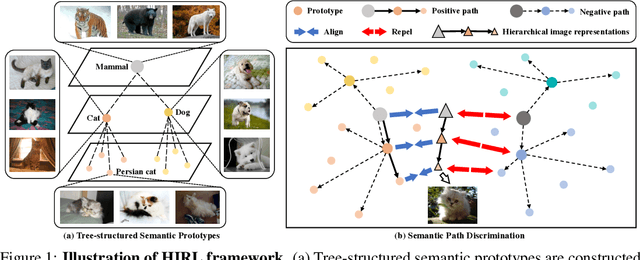
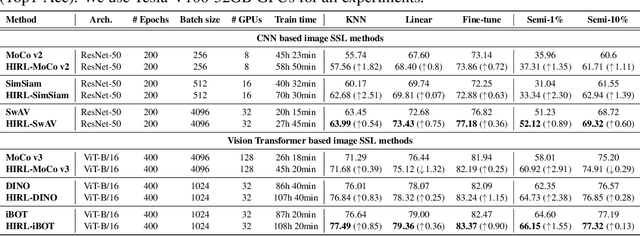
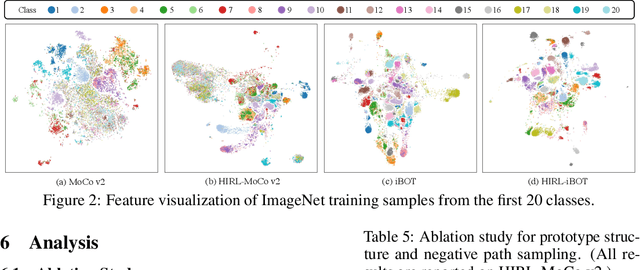
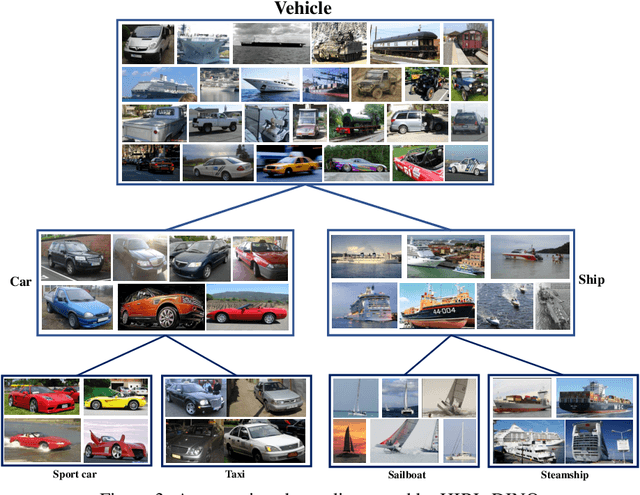
Abstract:Learning self-supervised image representations has been broadly studied to boost various visual understanding tasks. Existing methods typically learn a single level of image semantics like pairwise semantic similarity or image clustering patterns. However, these methods can hardly capture multiple levels of semantic information that naturally exists in an image dataset, e.g., the semantic hierarchy of "Persian cat to cat to mammal" encoded in an image database for species. It is thus unknown whether an arbitrary image self-supervised learning (SSL) approach can benefit from learning such hierarchical semantics. To answer this question, we propose a general framework for Hierarchical Image Representation Learning (HIRL). This framework aims to learn multiple semantic representations for each image, and these representations are structured to encode image semantics from fine-grained to coarse-grained. Based on a probabilistic factorization, HIRL learns the most fine-grained semantics by an off-the-shelf image SSL approach and learns multiple coarse-grained semantics by a novel semantic path discrimination scheme. We adopt six representative image SSL methods as baselines and study how they perform under HIRL. By rigorous fair comparison, performance gain is observed on all the six methods for diverse downstream tasks, which, for the first time, verifies the general effectiveness of learning hierarchical image semantics. All source code and model weights are available at https://github.com/hirl-team/HIRL
 Add to Chrome
Add to Chrome Add to Firefox
Add to Firefox Add to Edge
Add to Edge